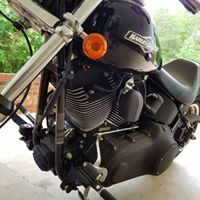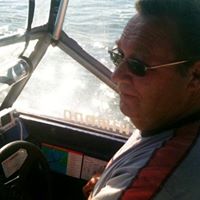Ray Dean Shepherd
age ~72
from Celina, TX
- Also known as:
-
- Ray D Shepherd
- Ray O Shepherd
- Ray Shepherd Dean
- Ray D Shepard
- Dean Shepherd Ray
Ray Shepherd Phones & Addresses
- Celina, TX
- 12512 S 15Th Ct, Jenks, OK 74037
- 315 Darlington Ave, Tulsa, OK 74112 • 9184962699
- 8952 Darlington Ave, Tulsa, OK 74137 • 9184962699
- Fresno, CA
- 2657 Albany St, Broken Arrow, OK 74014 • 9183551799
- Bartlesville, OK
- Manassas, VA
Work
-
Position:Precision Production Occupations
Education
-
Degree:High school graduate or higher
Resumes

Ray Shepherd
view source
Ray Shepherd
view source
Ray Shepherd
view source
Ray Shepherd
view source
Ray Shepherd
view sourceMedicine Doctors

Ray W. Shepherd
view sourceSpecialties:
Pulmonary Critical Care Medicine, Hematology/Oncology
Work:
Massey Cancer Center
1300 E Marshall St, Richmond, VA 23298
8048289992 (phone), 8048285941 (fax)
VCU Medical Center Pulmonary Specialties
417 N 11 St FL 4, Richmond, VA 23298
8048282161 (phone), 8048271703 (fax)
1300 E Marshall St, Richmond, VA 23298
8048289992 (phone), 8048285941 (fax)
VCU Medical Center Pulmonary Specialties
417 N 11 St FL 4, Richmond, VA 23298
8048282161 (phone), 8048271703 (fax)
Education:
Medical School
University of North Carolina School of Medicine at Chapel Hill
Graduated: 1996
University of North Carolina School of Medicine at Chapel Hill
Graduated: 1996
Procedures:
Lung Biopsy
Lumbar Puncture
Pulmonary Function Tests
Vaccine Administration
Lumbar Puncture
Pulmonary Function Tests
Vaccine Administration
Conditions:
Pneumonia
Acute Bronchitis
Acute Sinusitis
Bronchial Asthma
Epilepsy
Acute Bronchitis
Acute Sinusitis
Bronchial Asthma
Epilepsy
Languages:
English
Description:
Dr. Shepherd graduated from the University of North Carolina School of Medicine at Chapel Hill in 1996. He works in Richmond, VA and 1 other location and specializes in Pulmonary Critical Care Medicine and Hematology/Oncology. Dr. Shepherd is affiliated with Virginia Commonwealth University Medical Center.
Isbn (Books And Publications)







Name / Title
Company / Classification
Phones & Addresses
Principal
Applied Automation Inc
Whol Industrial Equipment
Whol Industrial Equipment
8952 S Darlington Ave, Tulsa, OK 74137
Incorporator
BOLIVAR WATER ASSOCIATION, INC
President
Gregory Electric, Inc. Which Will DO Business In California As Colorado Gregory Electric, Inc
Us Patents
-
Data Transport Architecture
view source -
US Patent:7991931, Aug 2, 2011
-
Filed:May 2, 2007
-
Appl. No.:11/743209
-
Inventors:Glen E. Schmidt - Bartlesville OK, US
Michel J. Baillargeon - Bartlesville OK, US
Robert Farmer - Bartlesville OK, US
Gregory J. Golden - Owasso OK, US
Ray Shepherd - Tulsa OK, US -
Assignee:Siemens Industry, Inc. - Alpharetta GA
-
International Classification:G06F 13/00
H01C 7/12
G06F 13/42 -
US Classification:710100, 710 72, 710104, 710105, 710106, 361119
-
Abstract:The present invention is a novel device, system, and method for data transport and bus architecture. According to an exemplary embodiment of the present invention, the bus architecture may comprise of a continuous serial bus that may be incorporated into a process control sample system to provide an intrinsically safe and efficient system. An alternative exemplary embodiment, in an intrinsically safe control sampling system, a data transport device may be used to couple sampling controls and analyzers. An exemplary embodiment of the present invention may contain an access controller providing a protocol bridge for an intrinsically safe control sampling system to couple sampling controls and analyzers.
-
Method And Apparatus For Serial Bus Communication
view source -
US Patent:20080189456, Aug 7, 2008
-
Filed:Jan 30, 2008
-
Appl. No.:12/022375
-
Inventors:Glen E. Schmidt - Bartlesville OK, US
Gregory J. Golden - Owasso OK, US
Bob Farmer - Bartlesville OK, US
Michel Baillargeon - Bartlesville OK, US
Ray Shepherd - Tulsa OK, US
Thomas Burghardt - Schwabach, DE -
International Classification:G06F 13/42
-
US Classification:710106
-
Abstract:A system and method for providing a serial communication bus is disclosed. A serial communication bus connects multiple footprint devices, such as electronic sensors in a process control sample system. The footprint devices can utilize various footprint device specific communication protocols. Multiple tophat devices act as general I/O ports for connecting with the footprint devices. Each tophat device identifies the footprint device specific communication protocol of a connected footprint device, converts outputs signals transmitted from the connected footprint device from the footprint device specific communication protocol of the footprint device to a standard bus communication protocol, and converts input signals directed to the connected footprint device from the standard bus communication protocol to the footprint device specific communication protocol of the footprint device. The serial communication bus connects the tophat devices and transmits input and output signals using the standard bus communication protocol.
-
Method And Computer Program Product For Processing Chromatograms Obtained By A Process Gas Chromatograph
view source -
US Patent:20120242489, Sep 27, 2012
-
Filed:Mar 25, 2011
-
Appl. No.:13/072036
-
Inventors:Aosheng WANG - Eden Prairies MN, US
Ray Dean Shepherd - Tulsa OK, US -
Assignee:Siemens Aktiengesellschaft - Munchen
-
International Classification:G08B 17/10
G01N 30/02 -
US Classification:340632, 73 2336, 73 2335
-
Abstract:The invention relates to a method for processing chromatograms obtained by a process gas chromatograph in a plurality of subsequent measurements of a process stream. To reduce the computational effort and time while maintaining high accuracy, the method comprises collecting a set of chromatograms from a predefined number of subsequent measurements, selecting one of the chromatograms of the set as a reference chromatogram, aligning solely by cross-correlation and shifting each other of the collected chromatograms to the selected chromatogram, performing a multivariate analysis on the aligned chromatograms to extract systematic information, performing, based on the information, a peak analysis on the latest chromatogram of the set and outputting the result of the peak analysis, and for a new measurement, excluding the chromatogram of the oldest measurement from the set of chromatograms, including the chromatogram from the new measurement and continuing with the step of selecting one of the chromatograms of the set as a reference chromatogram
-
Gas Chromatograph
view source -
US Patent:20130239656, Sep 19, 2013
-
Filed:Mar 14, 2012
-
Appl. No.:13/420233
-
Inventors:Aosheng Wang - Eden Prairie MN, US
Ray Dean Shepherd - Tulsa OK, US
Christoph Klawun - Bartlesville OK, US -
Assignee:Siemens Aktiengesellschaft - Muenchen
-
International Classification:G01N 30/02
-
US Classification:73 234
-
Abstract:A gas chromatograph comprising a separation column for separating components of a sample of a gas mixture fed through the separation column by a carrier gas, a thermal conductivity detector including a sensing element arranged downstream from the separation column and configured to detect the separated components in a non-destructive manner and to generate a detector signal in response the detected components, an evaluation unit for evaluating the detector signals to determine concentrations of the detected components, and a further thermal conductivity detector including a further sensing element arranged immediately downstream or upstream from the thermal conductivity detector and configured to detect the separated components and to generate a further detector signal in response to the detected components, where the evaluation unit is configured to compare the detector signal with the further detector signal to recognize and signal a loss of or improper detection by the thermal conductivity detector.
-
Gas Chromatograph
view source -
US Patent:20140076023, Mar 20, 2014
-
Filed:Sep 4, 2013
-
Appl. No.:14/018185
-
Inventors:Aosheng WANG - Eden Prairies MN, US
Ray Dean SHEPHERD - Tulsa OK, US
Christoph KLAWUN - Bartlesville OK, US -
International Classification:G01N 30/66
-
US Classification:73 234
-
Abstract:A gas chromatograph in which components of a sample of a gas mixture are separated via a separation column, a sensing element of a thermal conductivity detector is operated at a first temperature to detect separated components and to generate a detector signal in response to detected components, an evaluation unit evaluates detector signals and determines concentrations of detected components, a further sensing element of a further thermal conductivity detector is operated at a second temperature different from the first temperature, to detect gas components of widely different concentration ranges at high sensitivity, where the thermal conductivity detectors are calibrated for different concentration ranges, and the evaluation unit compares the detector signal with the detector signal of the further thermal conductivity detector to output a concentration value determined from the signal of the thermal conductivity detector calibrated for the measured component concentration.
Plaxo

Ray Shepherd
view sourceMadison Heights Mi
Classmates

Ray Shepherd
view sourceSchools:
Landmark High School Spanish Fork UT 1974-1978
Community:
Robert Reichert, Jenny Garcia

Ray Shepherd
view sourceSchools:
Landmark High School Spanish Fork UT 1978-1979
Community:
Robert Reichert, Jenny Garcia

Ray Shepherd
view sourceSchools:
North Vernon High School North Vernon IN 1964-1968
Community:
Linda Landry, Diana Taylor

Ray Shepherd
view sourceSchools:
Northridge High School Dayton OH 1982-1986
Community:
Bill Miller, Fred Coates

Ray Shepherd
view sourceSchools:
Woodward High School Woodward OK 1971-1975
Community:
Wendy Brown, Chris Boyter, Vickie Noreuil, D'anna Wood

Ray Shepherd
view sourceSchools:
Newton High School Newton KS 1961-1965
Community:
Phil Llamas, Marvetta Church, Jim Guhr, Anne Svaty, Arthur Clark, Robin Bruner, Cheryl Williams, Jack Spratt, Daniel Dietrich, Steve Mccullough, Greg Hull

Ray Shepherd
view sourceSchools:
Whitman-Hanson Regional High School Whitman MA 1962-1966
Community:
Dean Sault, Michael Papanicolas, Rita Wright, Stephen Ohrenberger, Janet Marini, Marilyn Meinhold, William Mcavoy, Steven Tarr, Linda Thompson

Ray Shepherd Elementary S...
view sourceYoutube
Myspace
Googleplus

Ray Shepherd

Ray Shepherd
view source
Dustin Ray Shepherd
view source
Ray Shepherd
view source
Sabrina Ray Shepherd
view source
Cody Ray Shepherd
view source
Rivera Ray Shepherd
view source
Ray Shepherd
view source
Ray Shepherd
view sourceFlickr
Get Report for Ray Dean Shepherd from Celina, TX, age ~72

















